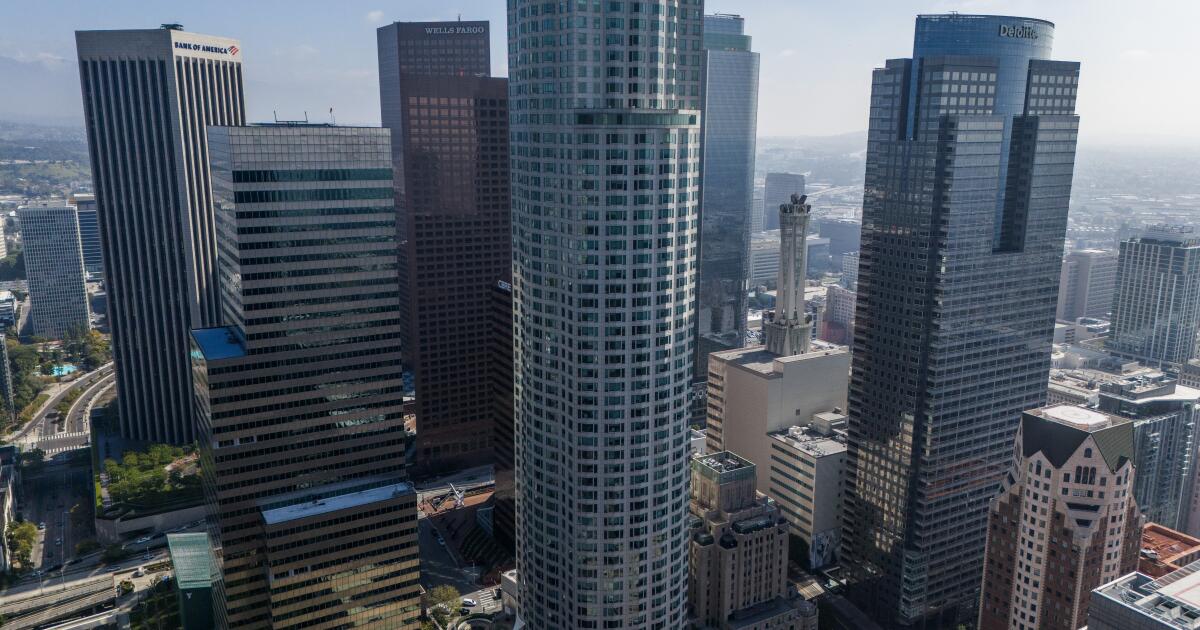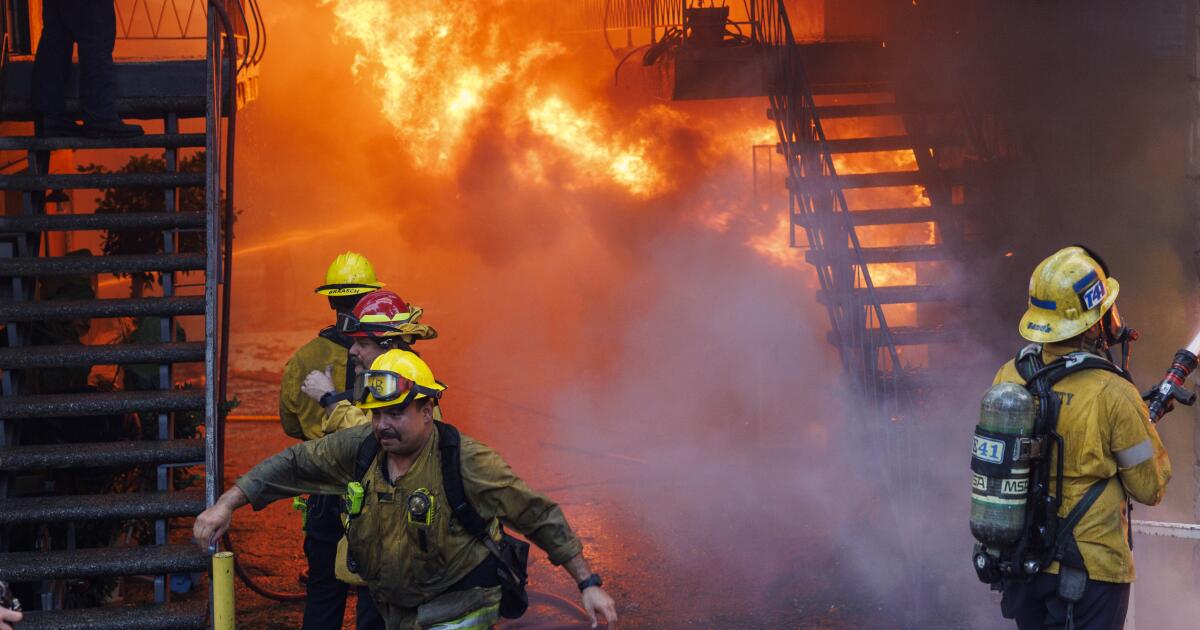Business
The end of Hahn Hall? L.A. County takes first step to buy Gas Company Tower

L.A. County’s Board of Supervisors took its first major step Tuesday toward buying Gas Company Tower, one of the most prominent office skyscrapers in downtown Los Angeles.
The looming purchase could move workers and public services out of existing county offices, including the well-known Kenneth Hahn Hall of Administration, which dates to 1960. The building is one of roughly 33 county-owned facilities that engineers say are vulnerable to collapse during a major earthquake.
The supervisors voted 3-1 to let the county’s Chief Executive Office move forward with the purchase, which they said cannot exceed $200 million. The board will need to vote again before the deal is finalized.
Supervisor Janice Hahn voted against the purchase, telling her colleagues she was concerned about the fate of the downtown civic center if the Hall of Administration shut down. The building is named after her father, longtime Supervisor Kenneth Hahn.
“I know there’s a tendency to jump on real estate deals,” she said. “We have to think bigger.”
Supervisor Hilda Solis abstained from the vote, saying she wanted to see “a more comprehensive and practical plan” to address the county’s aging buildings before giving her support. She also noted that the county had already sunk about $25 million into a plan to make the Hall of Administration seismically safe and still had several buildings downtown in need of upgrades, including Men’s Central Jail.
“I want to make sure that we know exactly what we’re getting ourselves into before committing any funding to this purchase,” she said.
The proposed price is a deep discount from the building’s appraised value of $632 million in 2020, underscoring how much downtown office values have fallen in recent years.
After selling last year for $110 million, Union Bank Plaza on Figueroa Street sold again recently for just $80 million, or $114 per square foot, according to real estate data provider CoStar. Another downtown high-rise tower at 777 S. Figueroa St. recently sold for $120 million, or $115 per square foot.
At $200 million, the county would get the Gas Company Tower for about $137 a square foot, still a bargain by historical standards.
“All these prices are a massive discount from only three years ago, when 915 Wilshire Blvd. traded for over $500 a foot,” said real estate broker Kevin Shannon of Newmark, who helped arrange the Union Bank Plaza sale to the Southwest Carpenters Pension Trust. “The world has changed.”
It makes sense for entities like the county and the Carpenters Pension Trust to buy their own buildings because they can lock in their occupancy costs long term, Shannon said.
The 52-story tower at 555 W. 5th St. was widely considered one of the city’s most prestigious office buildings when it was completed in 1991. It has nearly 1.5 million square feet of space on a 1.4-acre site at the base of Bunker Hill.
In recent years, the downtown office market has turned against landlords as many tenants reduced their office footprint in response to the COVID-19 pandemic, when it became more common for employees to work remotely.
Last year, the owner of the Gas Company Tower, an affiliate of Brookfield Asset Management, defaulted on its debt and the property was put in receivership, in which a court-appointed representative took custody of the building to help creditors recover funds they lent to Brookfield. The building has about $465 million in outstanding loans.
Elevated interest rates have weighed on prices by making it difficult for building owners to refinance debt and pushing them into quick sales or foreclosures. Some downtown L.A. office tenants have left for other local office centers including Century City over concerns that the streets are less safe than before the pandemic.
Southern California Gas Co. said last month it is planning to move from its longtime headquarters in its namesake tower, where it has been a primary tenant since the building was completed, and move a block north to another skyscraper, at 350 S. Grand Ave.
The utility signed a long-term lease for nearly 200,000 square feet on eight floors in the Grand Avenue building on Bunker Hill often known as Two California Plaza, its new landlord said, and is expected to move by spring 2026 after building out the new offices. The Gas Company will also have an office on the ground floor to serve customers.
Other major tenants in the Gas Company Tower include law firm Latham & Watkins and accounting firm Deloitte.
The building is in good condition with “a remaining useful life” of no less than 35 years, according to a recent property condition report prepared for the current owner that was obtained by The Times.
The report also said the tower and parking garage need about $1.3 million to address urgently needed repairs and deferred maintenance. Additional long-term costs to maintain and modernize the properties were estimated at about $48.7 million over 12 years. Projected costs include roof repairs, refurbishing air conditioning systems and updating the elevators.
Seismic engineers are conducting an “in-depth evaluation” of how the building would respond in a major earthquake to determine whether the Gas Company Tower, the fifth-tallest member of the downtown skyline, has vulnerabilities that need to be addressed, an L.A. County spokesperson said last month.
“Those issues are exactly what we are exploring through our due diligence,” the county said in a statement. “Without getting ahead of the work currently underway, one factor is assessing how this building would perform compared to the performance of the Hall of Administration, and the respective costs of each approach.”

Business
How the devastating Los Angeles fires could deepen California's home insurance crisis

When raging wildfires tore through Pacific Palisades and other local communities this week, they not only left a path of destruction reminiscent of a World War II bombing campaign, but threatened to deepen a crisis that has already left hundreds of thousands of Californians struggling to find and keep affordable homeowners insurance.
The multiple fires from Los Angeles to the San Gabriel Valley that have burned thousands of structures since Tuesday — leading to losses that by one early estimate are well into the tens of billions of dollars — hit Southern California as insurers have been dropping customers statewide citing the increasing number and severity of wildfire-related losses.
The Palisades fire alone, which consumed more than 5,000 homes and structures, is being called the most destructive fire ever to hit the city, while the fires across the county are likely to be one of the most expensive natural disasters in U.S. history.
“It’s just an unmitigated disaster,” said Amy Bach, executive director of United Policyholders, a consumer advocacy group. “Wildfires in January? This just proves insurers’ point that the risk is so significantly increased due to climate change.”
State Farm, the state’s largest home insurer, announced in March it would not renew 72,000 property insurance policies, while Chubb and its subsidiaries stopped writing new high-value homes with higher wildfire risk — just to name two insurers that pulled back from the California market.
It’s not clear how many homeowners in Pacific Palisades and elsewhere might not have had coverage, but at least some homeowners reported that insurers had not renewed their policies before the disaster struck. Actor James Woods, who lost his home in the Palisades fire, tweeted Tuesday that “one of the major insurances companies canceled all the policies in our neighborhood about four months ago.”
State Farm last year told the Department of Insurance it would not renew 1,626 policies in Pacific Palisades when they expired, starting last July.
A spokesperson for State Farm declined to comment on the decision but said: “Our number one priority right now is the safety of our customers, agents and employees impacted by the fires and assisting our customers in the midst of this tragedy.”
The situation has left many homeowners in neighborhoods at high wildfire risk with little choice but to seek relief from the California FAIR Plan, an insurer of last resort that sells policies with lesser coverage. The policies cover losses up to $3 million to a dwelling and its contents caused by certain hazards, such as fire, but do not include personal liability and other protection that are typically offered by private insurers.
The FAIR Plan has seen its policies grow from a little over 200,000 in September 2020 to more than 450,000 as of last September. That has roughly tripled its loss exposure to $458 billion over the same period. Pacific Palisades has one of the state’s highest concentrations of FAIR Plan policy holders, with the insurer estimating its exposure in the neighborhood at $5.89 billion.
JP Morgan analysts estimate that total L.A. County losses could be close to $50 billion, while the losses insurers will have to pay could top $20 billion. Another estimate puts the losses even higher.
Such losses could cause insurers to exit the market completely, which Tokio Marine America Insurance Co. and Trans Pacific Insurance Co. said in April they would do in not renewing 12,556 homeowners.
The losses also could prompt insurers to further raise premiums, even though some insurers already have been granted big rate hikes, such as a 34% increase Allstate received last year.
Denise Rappmund, senior analyst at Moody’s Ratings, said, “These events will continue to have widespread, negative impacts for the state’s broader insurance market — increased recovery costs will likely drive up premiums and may reduce property insurance availability.”
Should insurers further withdraw from the market, that would put additional pressure on the FAIR Plan, which is is backed by the state’s licensed insurers, such as State Farm, who have to pay claims if they exceed the FAIR Plans reserves, reinsurance and catastrophe bonding. The insurers also can assess their own policyholders surcharges in the billions of dollars to bail out the plan under regulations put in place last year by Insurance Commissioner Ricardo Lara as part of his Sustainable Insurance Strategy to help the crippled market.
It’s unclear whether the plan will be able to absorb the losses like it did after the 2018 Camp fire that destroyed the town of Paradise in North California. That conflagration was the single costliest natural disaster in the world that year with $12.5 billion in covered losses and $16.5 billion in total losses, according to the reinsurance firm, Munich RE.
“This further complicates an already complicated and hardened market,” Lara said of the fires, in an interview with The Times.
Nonetheless, Lara’s reforms seek to ensure the FAIR Plan remains solvent and to make it more attractive for insurers to write policies in fire risky neighborhoods now being absorbed by the program. He said the regulations should encourage insurers to write more homeowners policies, and if not, they can be adjusted. “I feel very confident,” he said.
For the first time, California insurers can use so-called “catastrophe models” in setting their rates. Instead of largely relying on past claims data, the computer programs attempt to better refine an insurer’s risk by taking into account a multitude of variables that affect a property’s likelihood to suffer a loss.
The other major policy change allows insurers to charge California homeowners for the cost of reinsurance they buy from other insurers to limit their losses during huge catastrophes, such as wildfires and floods. This cost shift to policyholders is common elsewhere but a big change for California, where it will raise premiums.
In return for those concessions, insurers will have to write insurance in high-risk wildfire neighborhoods equivalent to 85% of their market share, meaning an insurer with a 10% statewide market share would have to cover 8.5% of the homes in such neighborhoods — a target they have at least two years to reach. Lara’s plan has been blasted by the Los Angeles group, Consumer Watchdog, which says the regulations lack teeth in actually requiring insurers to meet the coverage goals.
“The Sustainable Insurance Strategy is not a magic wand. It’s a set of incentives,” Bach said. “At the end of the day, insurers are always still going to analyze, ‘Are we going to make money here or not?’”
How much this week’s fires will disrupt the already troubled insurance market depends, of course, on how big a disaster they are — but all indications are that insurers will have to absorb billions of dollars of claims given the number of homes destroyed, especially in the wealthy enclave of Pacific Palisades, where the average home is valued at about $3.5 million by Zillow.
Insurance industry experts say a clearer picture on the estimated losses will only come after adjusters have time to review submitted claims.
“I think it’s going to be 45 days before we know what the true damage is,” said Max Gilman, president of California personal lines at the brokerage HUB International.
Whatever the final cost, Gilman noted that the fires came after a couple of relatively light fire seasons — though in November the Mountain fire in Ventura County scorched more than some 20,640 acres and destroyed more than 130 homes amid parched conditions. That made it at the time the third most destructive fire in Southern California in a decade.
“I think what’s currently transpiring is going to be of grave concern for the future,” he said. “I feel like we we took three steps forward to take five steps back.”
Denne Ritter, a vice president with the American Property Casualty Insurance Assn. trade group, said it is too early to assess the impact of the fires on Lara’s reforms, especially given how they are just being put in place. Only one catastrophe model has been submitted for review to regulators, while the reinsurance regulation released last month still awaits final approval by the Office of Administrative Law.
“What the insurance industry wants is a healthy market in California where we can compete for business, as we have historically. And the number one priority right now is helping our customers get the resources they need to rebuild their lives and restore their property,” she said.
However, she noted that Mercury Insurance — which recently announced it started writing insurance again in Paradise — and Farmers Insurance, which said last month it is increasing the number of new home policies it will write, have “certainly made moves indicating a more bullish approach on the market.”
Allstate also has said it will resume writing new policies once Lara’s reforms are in place and it can get rates that fully cover its costs.
But all those pronouncements came before this week’s catastrophic fires.
Business
Wildfires Will Deepen Housing Shortage in Los Angeles

Each of the homes burned in the Los Angeles fires is its own individual calamity.
Collectively, the losses — whether in the hundreds or, as is far more likely, in the thousands — will weigh on the city’s already urgent housing shortage.
Fires are still raging, and with 180,000 people under evacuation orders as of Thursday morning, the degree of displacement in the city and its surrounding areas will take time to assess. For the time being, evacuees are holing up in public shelters in Los Angeles County, with friends or family members or in hotels.
But in the coming weeks and months, people whose homes are gone will have to find more stable accommodations while they rebuild. That will not be easy in a metro area that, as of 2022, already had a shortage of about 337,000 homes, according to data from Zillow. The number of homes on the market in Los Angeles was 26 percent below prepandemic norms as of December, according to Zillow.
“One of the biggest challenges ahead will be getting people who lost their homes into permanent, long-term housing,” Victor M. Gordo, the mayor of Pasadena, said on Wednesday. Pasadena, which is battling the Eaton fire, has already lost hundreds of homes.
The area’s tight rental market is likely to become further strained as many of the thousands of displaced residents turn to rental units, while figuring out their next move. The median rent for a one-bedroom apartment in Los Angeles, as of Jan. 7, was more than $2,000, according to Zillow.
“You’re going to have a positive shock in demand, and a negative shock in supply, so this automatically means prices go up in the rental markets,” said Carles Vergara-Alert, a professor of finance at IESE Business School in Barcelona, who has studied the effects of wildfires on housing markets.
Any uptick in rental costs would affect tenants across the region, beyond those displaced by the fires, Dr. Vergara-Alert said.
Jonathan Zasloff, who lost his home in Pacific Palisades this week, teaches land use and urban policy at the University of California, Los Angeles law school, and is acutely aware of how his search for interim housing could affect the broader market.
Dr. Zasloff is staying with his brother for the time being, while a friend is putting up his wife and daughter. They evacuated their house, which they had lived in for almost 15 years, around noon on Tuesday, before the official evacuation order was issued for the area. That evening, Dr. Zasloff realized the severity of the crisis when he was watching television and saw a reporter standing on his fire-ravaged block.
His insurance agent told him it could take two to three years to rebuild his house. His family might try to find a rental in West Los Angeles near UCLA in the meantime, he said.
There aren’t many rentals in that part of the city, Dr. Zasloff said, so students and other renters could be displaced as he, and people like him who lost their homes, move in.
“It’s very possible that this event is going to cause a big increase in homelessness, even though the people who got pushed out of their homes are people of means,” he said.
California has been in the grip of an affordable housing crisis for a decade. Both state and local lawmakers have passed a raft of new laws that aim to make housing cheaper and more plentiful by making it easier to build. In Los Angeles, for instance, Mayor Karen Bass signed an executive order that streamlines permitting for projects in which 100 percent of the units are affordable. In response to state housing reforms, there has been a boom of backyard homes — called accessory dwelling units, or A.D.U.s — that homeowners often rent out for extra income and that have added to the housing stock.
Still, both the city and state remain well behind their housing production goals, and affordability has only continued to erode. The number of apartment units approved by the city of Los Angeles, for example, dipped to a 10-year low in 2024, according to data from the Los Angeles Department of Building and Safety compiled by Crosstown LA, a news site. That downturn in building permitting has raised concern about roadblocks to new housing unit creation.
“This is a place that had massive affordability challenges last week, and after this week it’s going to be that much more challenging,” said Dave Rand, a land-use lawyer at Rand Paster & Nelson in Los Angeles, who also serves on the board of directors of a statewide affordable housing organization.
After the fires are extinguished and the recovery begins, Mr. Rand said, there is hope that the common cause of rebuilding can be a catalyst for tackling affordability challenges by continuing to make it easier to build housing, particularly affordable rental housing, at a faster pace.
“This is such a devastating event that hopefully it rocks the system to the point where we can get real reform,” he said.
The Los Angeles City Council has aimed to build nearly half a million new units by 2029. But many people trying to rebuild all at once after the fires could lead to higher costs, and slow down the overall production of housing, said Jason Ward, a co-director of the center on housing and homelessness at the RAND Corporation.
A longstanding construction labor shortage in Los Angeles does not help. Andy Howard, a general contractor who has worked across the city for three decades, including in the areas affected by the fires, said many of the subcontractors he work with in the past have left California since the pandemic. And there are not enough young people entering the industry.
The fires are “going to make it worse,” Mr. Howard said. “It’s going to drive the cost up, for sure.”
Business
For Hollywood workers, L.A. fires are the latest setback as productions halt

As the market for documentaries and other content slowed and work dried up in Hollywood, producer Kourtney Gleason was already worried about making the mortgage payments on the home she bought last year with her boyfriend.
Now, as raging fires have halted film and TV production in Southern California and many in the industry have lost homes, she’s terrified that the entertainment business will be set back yet again. Though she’s been in the industry for 12 years, Gleason is now reluctantly looking at restaurant jobs to get by.
“The industry in the town is so fragile that every little thing becomes a bigger bump in the road,” she said. “Another bump that will push things back from getting ramped up.”
The destruction of the fires only compounds the difficult lot for many of Hollywood’s workers. Still reeling from the pandemic, they faced financial hardship during the dual Hollywood labor strikes in 2023, then were hit with a sustained slowdown in film and TV production that has driven many to rethink their careers in the industry.
“A lot of the below-the-line workers were already under an incredible amount of pressure,” said Kevin Klowden, executive director of the Milken finance institute. “For Hollywood workers, it becomes one more blow.”
The sheer scope of the region’s multiple fires means that nearly every echelon of Hollywood has been hard hit.
The Palisades fire, which has burned more than 17,200 acres and destroyed numerous homes, businesses and longtime landmarks in the Pacific Palisades area, is home to many Hollywood stars, studio executives and producers. Actors such as Billy Crystal and Cary Elwes lost homes in the blaze.
Across the region, the Eaton fire has now burned at least 10,600 acres in the Pasadena and Altadena areas and destroyed many structures. The San Gabriel Valley is home to many of the industry’s more modest or middle-class workers, who were already financially harmed by the production slowdown and relocation of shoots to other states or countries.
The fires could rank as one of the costliest natural disasters in U.S. history. A preliminary estimate calculated by AccuWeather, the weather forecasting service, put the damage and total economic loss at $52 billion to $57 billion, which could rise if the fires continue to spread. J.P. Morgan on Thursday raised its expectations of economic losses to close to $50 billion.
Many affected homeowners reported the insurers had dropped their policies, as some of the biggest insurers have stopped writing or renewing policies in high-risk coastal and wildfire areas. The complications with fire insurance, combined with the region’s problems with housing affordability and supply, will only be exacerbated by these fires, Klowden said, leading some to reconsider whether they can stay in California.
“It adds up,” he said. “How many more people decide they can’t afford to stay?”
Hollywood workers had been holding onto hope that 2025 would be a better year for work, perhaps closer to the levels they saw before the pandemic.
But with yet another disaster, “it feels like it’s just another weight that’s been placed,” said Jacques Gravett, a film editor who has primarily worked in television on such shows as “Power Book IV: Force” on Starz and “13 Reasons Why” on Netflix.
Gravett was out of work for 13 months between the pandemic and the strikes, and said he’s concerned about how already struggling workers will be able to absorb the financial blow from the fires.
“At least when you’re working and something happens, you have resources to get you by, and a lot of people don’t have the resources now,” said Gravett, who is co-chair of the Motion Picture Editors Guild’s African-American steering committee. “Now we’re faced with another tragedy for those who’ve been displaced. What do you do?”
The effect of the fires on industry workers could give lawmakers a push to approve Gov. Gavin Newsom’s proposed increase to the state’s film and TV tax credit program, which aims to lure production back to California and increase jobs in the Golden State, Klowden said.
“Right now, the industry desperately is waiting on the incentives to be expanded,” he said.
In the near term, discussions about new projects are already hitting a wall. Gary Lennon, showrunner of various “Power” spinoffs, including “Force,” said an agent told him there will likely be a temporary pause before anyone wants to talk about new ideas.
“Buyers and meetings for pitches being sold will take a hit for a moment,” Lennon said. “People are focused on what is immediately happening in front of them.”
Even before the fires, he said he was already getting two to three calls a week from production designers, editors, costume designers and others looking for work.
But once the industry is ready to ramp back, he said he thinks it will move quickly.
“So much has happened recently, I think production will start right away again because people do need to work,” Lennon said. “And that’s a good thing.”
-

 Business1 week ago
Business1 week agoThese are the top 7 issues facing the struggling restaurant industry in 2025
-

 Culture1 week ago
Culture1 week agoThe 25 worst losses in college football history, including Baylor’s 2024 entry at Colorado
-

 Sports1 week ago
Sports1 week agoThe top out-of-contract players available as free transfers: Kimmich, De Bruyne, Van Dijk…
-

 Politics1 week ago
Politics1 week agoNew Orleans attacker had 'remote detonator' for explosives in French Quarter, Biden says
-

 Politics1 week ago
Politics1 week agoCarter's judicial picks reshaped the federal bench across the country
-

 Politics6 days ago
Politics6 days agoWho Are the Recipients of the Presidential Medal of Freedom?
-

 Health5 days ago
Health5 days agoOzempic ‘microdosing’ is the new weight-loss trend: Should you try it?
-

 World1 week ago
World1 week agoIvory Coast says French troops to leave country after decades

/cdn.vox-cdn.com/uploads/chorus_asset/file/25825427/2192342441.jpg)












